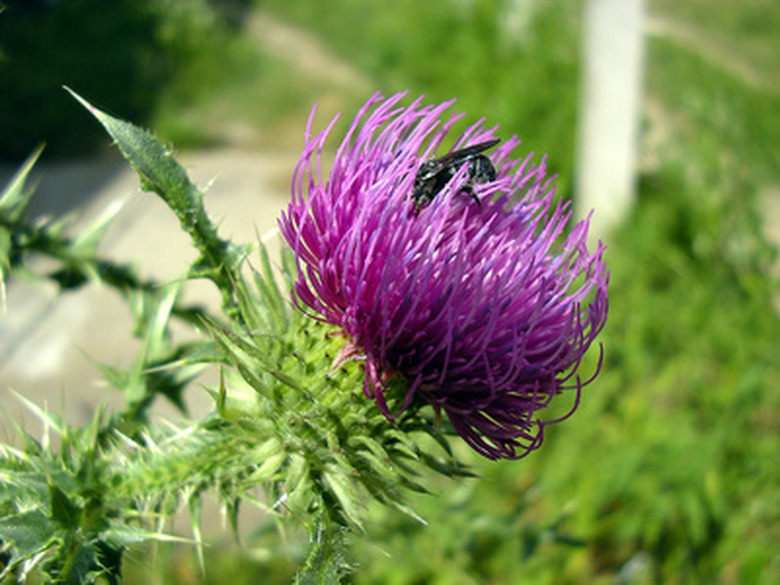How To Kill A Privet Bush With Chemicals
You probably see privet (Ligustrum spp.) bushes on every block as you drive around your neighborhood because they're such common shrubs for hedges. These evergreen shrubs and trees grow in U.S. Department of Agriculture plant hardiness zones 3 through 10, but exact zones vary among the 50 species. Privet can be invasive and spread to unwanted areas. A small piece of root left in the soil after pulling plants can re-sprout. Chemical herbicides work best to kill privet because they kill the plant's roots.
Step 1
Step 1
Cut large privet bushes with trunks greater than 1 inch in diameter back to about 4 inches from the ground, leaving a 4-inch stub sticking out from the ground.
- You probably see privet (Ligustrum spp.)
- Cut large privet bushes with trunks greater than 1 inch in diameter back to about 4 inches from the ground, leaving a 4-inch stub sticking out from the ground.
Step 2
Step 2
Drill a 1/4-inch-diameter hole as deep as possible into the top of the stump. Drill several holes spaced 2 to 3 inches apart if the stump is several inches wide. Skip this step if the trunk is less than 2 inches in diameter.
Step 3
Step 3
Pour full-strength glyphosate herbicide into the hole in the stump. Use a small paintbrush to brush glyphosate on the rest of the stump. Apply it especially liberally around the outside edge near the cambium layer, which is the vascular transport system that carries the herbicide down to the roots. The percentage of glyphosate varies among different products, but is usually between 41 and 53 percent glyphosate. This is best done in late summer to early fall while the privet is actively transpiring carbohydrates to the roots in preparation for winter dormancy.
- Drill a 1/4-inch-diameter hole as deep as possible into the top of the stump.
- Use a small paintbrush to brush glyphosate on the rest of the stump.
Step 4
Step 4
Cover the stump with plastic to prevent the herbicide from evaporating before it transpires to the roots. If you have a particularly large privet shrub, remove the plastic after the herbicide in the hole absorbs into the roots and refill the drilled hole. Replace the plastic. It can take several months for the herbicide to work its way to the roots and kill the plant; new shoots might develop in the meantime.
Step 5
Step 5
Mix a 2 to 3 percent solution of glyphosate herbicide in a spray bottle or garden sprayer to treat smaller privet plants and new shoots. Instructions for mixing varies among different products, but as an example, mix 41 percent glyphosate herbicide at a rate of 2 2/3 ounces glyphosate to 1 ounce of a surfactant such as vegetable oil and 1 gallon of water. The surfactant helps the herbicide stick to the leaves and stems.
- Cover the stump with plastic to prevent the herbicide from evaporating before it transpires to the roots.
- Mix a 2 to 3 percent solution of glyphosate herbicide in a spray bottle or garden sprayer to treat smaller privet plants and new shoots.
Step 6
Step 6
Spray the entire privet plant, including the leaves, stem and trunk, with the glyphosate solution. This is most effective during the active growing season from spring through summer, but you can apply it year-round, if desired. Do not spray on windy days because this can lead to over-spray of this non-selective herbicide onto other desired plants. Use this diluted spray if the privet bush is smaller than 1 inch in diameter and on any new shoots that you notice after killing a larger privet bush with the cut stump method.
Step 7
Step 7
Allow up to two weeks for the herbicide to dessicate the plant; the leaves dry up and fall off the privet. Spray the plant again if you notice no change or only minimal change after the two-week period.
Step 8
Step 8
Monitor the problem area frequently over the next year for signs of new privet shoots, which can sprout from active roots or viable seeds left in the soil. Spray the new shoots immediately with the diluted glyphosate solution. This may take persistent application for even longer than a year to completely kill
- Spray the entire privet plant, including the leaves, stem and trunk, with the glyphosate solution.
- Monitor the problem area frequently over the next year for signs of new privet shoots, which can sprout from active roots or viable seeds left in the soil.
Tip
Add an ounce of blue spray marking dye to the 2 to 3 percent glyphosate solution to mark the leaves as you spray them. This prevents you from spraying leaves twice and wasting the herbicide.
Tip
Any type of plastic works for covering a painted privet stump. You can wrap it with a piece of sheet plastic and use twine to tie it in place around the stump. Alternatively, you can cover it with a plastic grocery sack and tie the handles around the stump.
Things Needed
- Hand saw
- Power drill
- 1/4-inch drill bit
- Glyphosate herbicide
- Paintbrush
- Plastic
- Spray bottle or garden sprayer
- Vegetable oil
- Spray marking dye (optional)
References
- Fine Gardening: Genus Ligustrum (Privet)
- USDA Forest Service: Ligustrum Spp.
- Mississippi State University : Chinese Privet (Ligustrum Sinese)
- The Ohio State University Extension: Controlling Undesirable Trees, Shrubs, and Vines in Your Woodland
- USDA Natural Resources Conservation Service: Chinese Privet
- New South Wales Department of Primary Industries: Privet — Broad-leaf, Small-leaf and European
